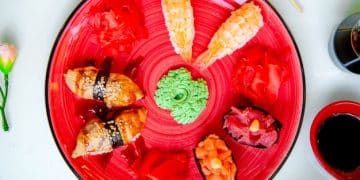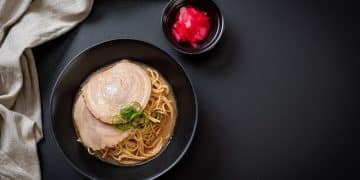Japan’s Foodie Paradise: A 2025 Culinary Journey for US Palates
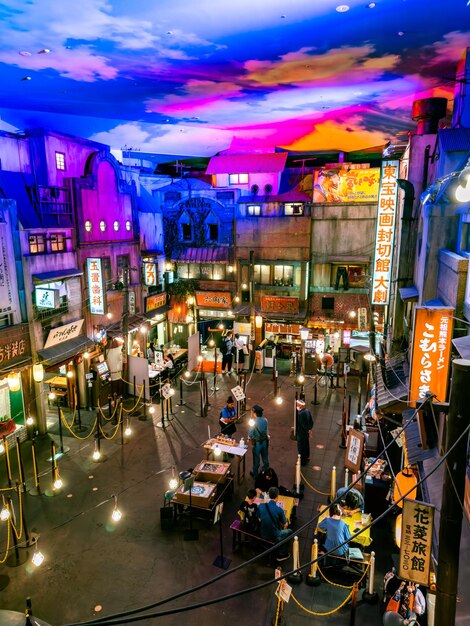
Japan’s Foodie Paradise: A Culinary Journey for US Palates in 2025 promises an immersive experience, blending traditional flavors with modern gastronomy, offering American travelers unique and unforgettable food adventures, from bustling street food to refined Michelin-starred dining.
Imagine yourself in 2025, wandering through vibrant Japanese markets, savoring exquisite sushi, and discovering regional delicacies you’ve never dreamed of. Japan’s Foodie Paradise: A Culinary Journey for US Palates in 2025 offers just that – and more, promising an unforgettable adventure.
Discovering Authentic Japanese Cuisine in 2025
Japanese cuisine is more than just sushi and ramen; it’s an art form deeply rooted in history and tradition. The year 2025 will bring even more opportunities for US travelers to explore the diverse culinary landscape of Japan.
The Essence of Washoku
Washoku, traditional Japanese cuisine, emphasizes fresh, seasonal ingredients and meticulous preparation. It’s a UNESCO-recognized cultural treasure that reflects the harmony between nature and the dining table.
Regional Culinary Variations
From Hokkaido’s seafood to Kyushu’s rich tonkotsu ramen, each region in Japan boasts unique culinary specialties. Exploring these regional variations is a must for any foodie visiting in 2025.
- Hokkaido: Known for its fresh seafood, including crab, salmon, and sea urchin. Don’t miss trying the local ramen variations.
- Kyoto: Famous for its refined kaiseki cuisine, a multi-course meal that showcases seasonal ingredients. Also, try the local matcha sweets.
- Osaka: Often called the “nation’s kitchen,” Osaka is known for its street food like takoyaki (octopus balls) and okonomiyaki (savory pancake).
- Fukuoka: Famous for its Hakata ramen (tonkotsu ramen) and fresh seafood. Try the local motsunabe (hot pot with offal).
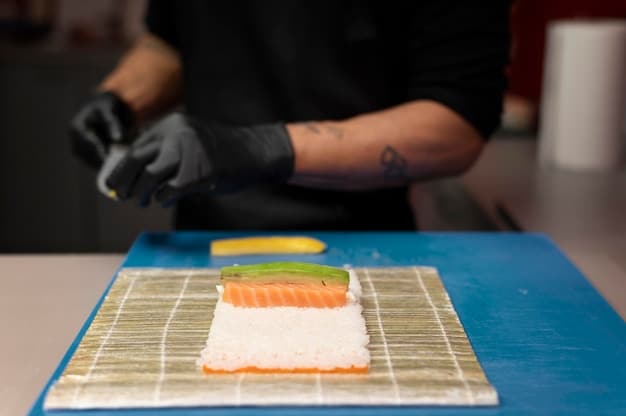
In conclusion, exploring authentic Japanese cuisine involves understanding Washoku’s principles and diving into regional specialties. Each area offers unique culinary experiences, ensuring a fulfilling journey for US palates in 2025.
Must-Try Dishes for US Tourists in 2025
For US tourists visiting Japan in 2025, certain dishes are essential to experience the full breadth of Japanese culinary delights. These dishes range from the traditional to the modern, providing a diverse and delicious adventure.
Iconic Sushi and Sashimi
No trip to Japan is complete without indulging in fresh sushi and sashimi. From affordable conveyor belt sushi to high-end omakase experiences, there’s something for every budget and palate.
Ramen: A Noodle Lover’s Dream
Ramen is a beloved noodle soup with countless regional variations. Explore different broths, toppings, and noodle types for a truly immersive experience.
- Tonkotsu Ramen: A rich, pork-bone broth often found in Kyushu.
- Shoyu Ramen: A soy sauce-based broth common in Tokyo.
- Miso Ramen: A fermented soybean paste broth popular in Hokkaido.
- Shio Ramen: A salt-based broth known for its light and clear flavor.
Tempura: Light and Crispy Delights
Tempura, lightly battered and deep-fried seafood and vegetables, offers a delightful contrast of textures and flavors. Enjoy it with dipping sauce and grated daikon radish.
In conclusion, from the artistry of sushi to the comforting warmth of ramen and the crispy delight of tempura, these must-try dishes provide a comprehensive culinary journey for US tourists exploring Japan’s foodie scene in 2025.
Navigating Japanese Dining Etiquette
Understanding Japanese dining etiquette is crucial for a respectful and enjoyable culinary experience. These customs reflect the culture’s emphasis on harmony, gratitude, and consideration for others.
Using Chopsticks Correctly
Mastering the art of using chopsticks is essential. Avoid sticking them upright in your rice bowl, passing food directly from chopstick to chopstick, and waving them around.
Saying “Itadakimasu” and “Gochisosama deshita”
Say “itadakimasu” before eating to express gratitude for the meal and “gochisosama deshita” after finishing to thank the host or chef.
The Importance of Slurping Noodles
Slurping noodles is not only accepted but also encouraged. It enhances the flavor and helps cool down the noodles, showing appreciation for the dish.
- Chopstick Usage: Practice using chopsticks before your trip to feel comfortable.
- Table Manners: Avoid placing your elbows on the table and keep your posture upright.
- Sharing Dishes: Typically, individual portions are served, but when sharing, use the serving utensils provided.
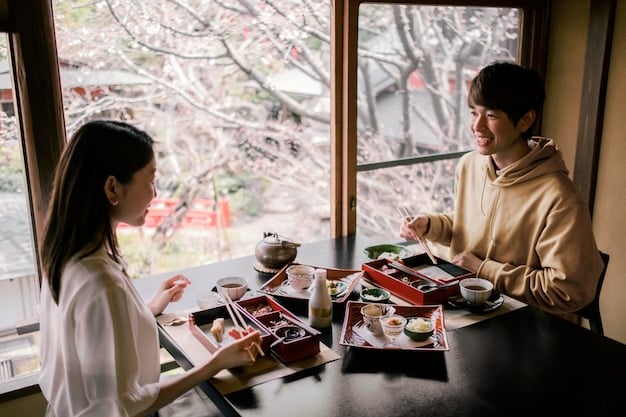
In conclusion, understanding and respecting Japanese dining etiquette will enhance your culinary journey and demonstrate your appreciation for the culture. Simple gestures like saying “itadakimasu” and practicing proper chopstick etiquette go a long way in showing respect and gratitude.
Exploring Japan’s Diverse Foodie Destinations
Japan offers a wide array of foodie destinations, each with unique culinary experiences. From bustling street food markets to serene tea houses, there’s something to satisfy every palate.
Tokyo: A Culinary Metropolis
Tokyo boasts a remarkable concentration of Michelin-starred restaurants and diverse culinary offerings, from traditional Japanese cuisine to international flavors.
Osaka: The Nation’s Kitchen
Osaka is renowned for its vibrant street food scene and hearty dishes like takoyaki and okonomiyaki. It’s a must-visit destination for food lovers.
Kyoto: Refined and Traditional Flavors
Kyoto offers a refined dining experience with its kaiseki cuisine and traditional tea houses. Enjoy the delicate flavors and serene atmosphere.
- Tsukiji Outer Market (Tokyo): A bustling market with a variety of seafood and local produce.
- Dotonbori (Osaka): Famous for its street food and lively atmosphere.
- Nishiki Market (Kyoto): Known as “Kyoto’s Kitchen,” offering a variety of local specialties.
- Canal City Hakata (Fukuoka): A shopping and entertainment complex with a wide range of dining options.
In conclusion, exploring Japan’s foodie destinations provides a deep dive into the country’s culinary diversity. From the bustling streets of Osaka to the refined elegance of Kyoto, each city offers unique and unforgettable gastronomic adventures catering to US palates in 2025.
The Future of Japanese Cuisine: Trends to Watch in 2025
Japanese cuisine continues to evolve, blending traditional techniques with modern innovations. Several trends are shaping the future of food in Japan, making it an exciting time for US foodies to visit.
Sustainability and Ethical Sourcing
A growing emphasis on sustainability and ethical sourcing is influencing Japanese cuisine. Restaurants are increasingly focusing on locally sourced, seasonal ingredients.
Fusion Cuisine Innovations
Japanese chefs are experimenting with fusion cuisine, blending Japanese techniques and ingredients with international flavors. This results in innovative and exciting dishes.
The Rise of Plant-Based Options
Plant-based options are becoming more prevalent in Japan, catering to vegetarian and vegan diets. Restaurants are offering creative and delicious plant-based alternatives to traditional dishes.
- Local and Seasonal Ingredients: Restaurants are highlighting the use of local produce and seasonal flavors.
- Fermentation Techniques: Traditional fermentation methods are being rediscovered and applied to modern dishes.
- Technology in Cooking: Chefs are using advanced technology to enhance the precision and flavor of their dishes.
In conclusion, the future of Japanese cuisine is characterized by sustainability, fusion innovation, and the rise of plant-based options. These trends promise an exciting and diverse culinary landscape for US tourists exploring Japan in 2025.
Planning Your Culinary Trip to Japan in 2025
Planning a culinary trip to Japan requires careful consideration of timing, transportation, and accommodation. Ensure a seamless and enjoyable foodie adventure by preparing in advance.
Best Times to Visit for Foodies
Spring and autumn offer pleasant weather and seasonal ingredients, making them ideal times for a culinary trip. Consider timing your visit with local food festivals.
Transportation Tips for Food Explorers
Utilize Japan’s efficient public transportation system, including the Shinkansen (bullet train), to easily navigate between cities and regions. Consider purchasing a Japan Rail Pass for cost-effective travel.
Accommodation Options for Culinary Travelers
Choose accommodations that are conveniently located near major foodie destinations. Options range from traditional ryokans to modern hotels with on-site restaurants.
- Researching Restaurants: Read reviews and make reservations in advance, especially for popular or Michelin-starred establishments.
- Learning Basic Japanese Phrases: Knowing a few basic Japanese phrases will enhance your interactions with locals and improve your dining experience.
- Budgeting for Food: Plan your budget according to your dining preferences, from affordable street food to high-end restaurants.
In conclusion, careful planning is essential for a successful culinary trip to Japan in 2025. By considering the best times to visit, utilizing efficient transportation, and choosing convenient accommodations, US foodies can ensure an unforgettable gastronomic adventure.
| Key Highlight | Brief Description |
|---|---|
| 🍣 Must-Try Dishes | Sushi, ramen, and tempura are essential culinary experiences. |
| 🥢 Dining Etiquette | Learn chopstick usage and “itadakimasu/gochisosama deshita.” |
| 🏙️ Foodie Destinations | Tokyo, Osaka, and Kyoto offer diverse culinary experiences. |
| 🌱 Future Trends | Sustainability, fusion cuisine, and plant-based options are growing. |
Frequently Asked Questions
▼
Spring and autumn are ideal due to pleasant weather and seasonal ingredients. These seasons offer unique culinary experiences and local food festivals.
▼
Must-try dishes include sushi, ramen, tempura, okonomiyaki, and takoyaki. Each offers a distinct flavor and culinary experience, reflecting Japanese cuisine’s diversity.
▼
Understanding dining etiquette is crucial for a respectful and enjoyable experience. Simple gestures show respect and appreciation, enhancing your interaction with locals.
▼
Tokyo, Osaka, and Kyoto are top foodie destinations. They offer Michelin-starred restaurants, street food, and traditional cuisine, catering to diverse culinary preferences.
▼
Sustainability, fusion cuisine, and plant-based options are key trends. These innovations are shaping the future of Japanese food, offering new and exciting culinary experiences.
Conclusion
Exploring Japan’s Foodie Paradise: A Culinary Journey for US Palates in 2025 promises an unforgettable adventure. From mastering dining etiquette to discovering iconic dishes and exploring diverse foodie destinations, prepare for a journey filled with unique flavors and cultural immersion.
